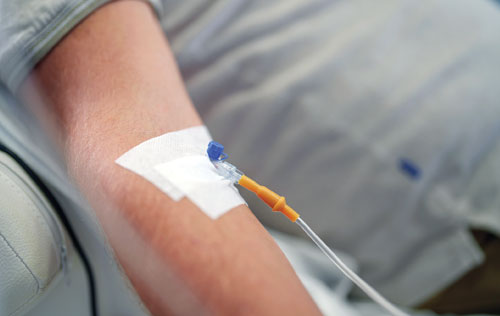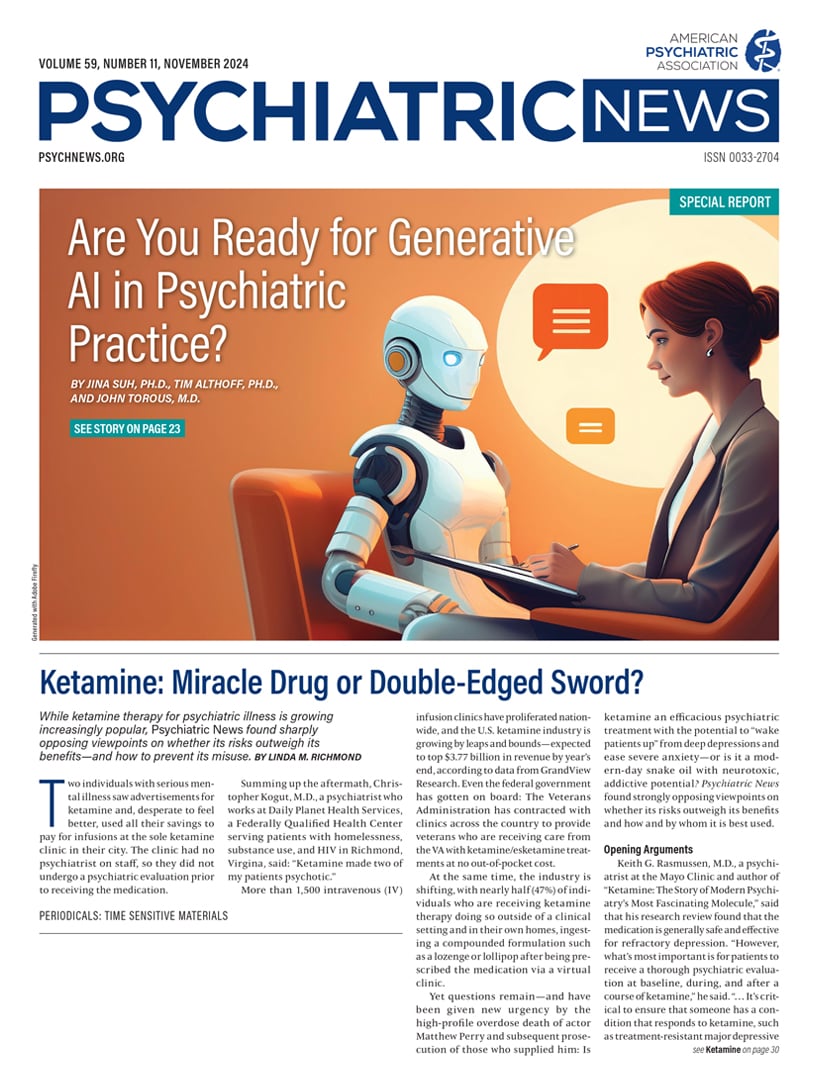When it comes to “real world” patients with treatment-resistant depression, fewer than 20% respond to ketamine infusion therapy, according to Cristina Cusin, M.D., founder and director of the Massachusetts General Hospital (MGH) Ketamine Clinic for Depression, who spoke about the clinic’s outcomes at APA’s 2024 Mental Health Services Conference in September.
Treatment response is defined as at least a 50% percent gain on the Quick Inventory of Depressive Symptomatology (QIDS). “You have to conduct a risk-benefit analysis for each patient to determine whether for that individual [ketamine] is worth it,” said Cusin, who is also an associate professor of psychiatry at Harvard Medical School and a researcher with the MGH Depression Clinical and Research Program.
Using flexible, personalized dosing, the MGH Ketamine Clinic has provided some 11,000 infusions since opening its doors in 2018. After expanding four times, the clinic now treats 16 patients a day—limited to individuals with refractory unipolar or bipolar depression who have been referred by their long-term psychiatrist.
Ketamine therapy gives hope to patients who have already tried nearly everything, many of whom are close to giving up, if they have not already done so. Yet a careful Plan B is also required: When ketamine is not effective, Cusin said, “patients feel they are at the end of their ropes and become really hopeless and more suicidal.”
‘You Must Make Sure It’s Sustainable’
“In clinical trials, they report a 60% to 70% response rate,” Cusin said. “We don’t see that.” However, about one-third in total have at least a partial response, which Cusin defines as a 35% or greater improvement in QIDS.
Cusin attributes the clinic’s lower response and remission rate to the greater illness burden of their patients. All of them are taking multiple psychotropics, have failed to respond to anywhere from four to 15 antidepressant medications, and have numerous medical and psychiatric comorbidities. One-quarter to one-third of the clinic’s patients have already tried and failed electroconvulsive therapy and/or transcranial magnetic stimulation.
“When patients have an exacerbation of stress or a COVID infection, for example, their depression gets worse, and the ketamine seems to work less,” Cusin said. Still, half of those treated choose to continue with ketamine maintenance, even some who are deemed non-responders. “Even the smaller improvement was enough for them.”
The clinic is not able to predict who is going to respond. However, use of illicit substances, particularly cannabis, blocks the effect of ketamine, so the clinic discourages patients with active substance use from obtaining treatments. Cusin also avoids treating those with current psychosis “because we don’t know if it’s safe. There is no data.”
Each ketamine infusion costs $550, according to the clinic website, and is not typically covered by insurance. Cusin said ongoing maintenance infusions are needed, so she has careful conversations about financial planning and scheduling at the outset. “Stopping is almost invariably associated with relapse,” and is almost worse than never starting, she said, adding that patients then return in crisis. “I tell patients, ‘If this works, you have to stick with the program.’ … So, you must make sure it’s sustainable.”
Side Effects and Adverse Events
Cusin said that patients rarely seem to be seeking the chance to get high—fewer than 1%. Regardless, euphoric effects dissipate after the first treatment or two. As for side effects and adverse events: 35% of the clinic’s patients require ondansetron or prochlorperazine for nausea, while another 30% to 40% require lorazepam for anxiety, dissociation, psychotic-like experiences, or perceptual disturbances. Most resolve within an hour of treatment, Cusin said.
Patients commonly experience insomnia the night after treatment, Cusin said. As for hypertensive episodes, they are more common with higher ketamine doses and in males over the age of 50.
While the clinic is reasonably sure that ketamine maintenance therapy is safe and effective, Cusin said there are concerns about this type of long-term, repeat, off-label use. They include the potential for Olney’s lesions, addiction, and neurotoxicity.
At the same time, the clinic treats patients as young as 15. “What are the long-term consequences of providing ketamine maintenance therapy on a young brain?” Cusin asked. “We don’t know what we don’t know.”
She discloses to her patients that beyond five years, “we have no idea…. Our fear is of some long-term unknown side effect. Most of our patients accept that and tell us, ‘I could be dead next month from suicide, so I’ll accept the potential downstream risk.’”
Cusin stressed that it is important to integrate cognitive behavioral or dialectical behavior therapy, education, and/rehabilitation into ketamine therapy. “A lot of our patients have forgotten how to live a life after 10 years of depression,” she said. “They have no relationships, no job, no structure, nothing. So, we have to figure out how to help them rebuild after the depression lifts.” ■

